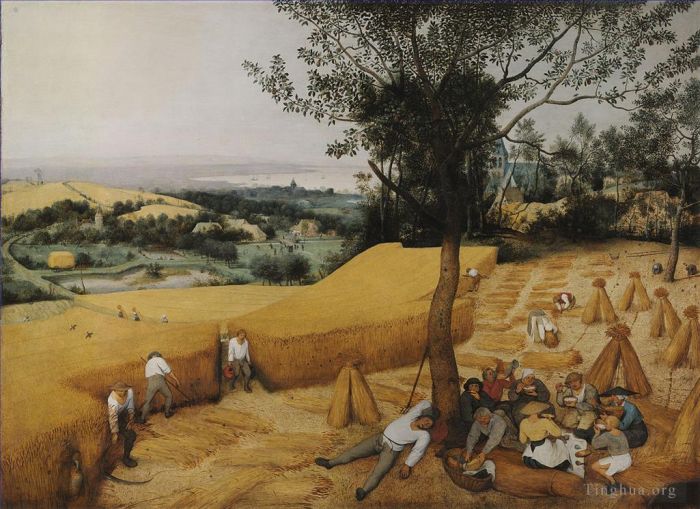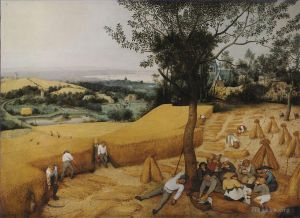The Harvesters
Pieter Brueghel the Elder
- Price: Price on Request
- Art Type: Oil Painting
- Size:
- English Comments: 0
- International Comments: 0
- Creating Date:
- Introduction and Works of Pieter Brueghel the Elder >>
Keywords:
Harvesters
Work Overview
- The Harvesters
Artist Pieter Brueghel the Elder
Year 1565
Type Oil on wood
Dimensions 119 cm × 162 cm ( 46 7⁄8 in × 63 3⁄4 in)
Location Metropolitan Museum of Art, New York City
The Harvesters is an oil painting on wood completed by Pieter Bruegel the Elder in 1565. It depicts the harvest time which most commonly occurred within the months of August and September. Nicolaes Jonghelinck, a merchant banker and art collector from Antwerp, commissioned this painting.
The painting is one in a series of six works, five of which are still extant, that depict different times of the year. As in many of his paintings, the focus is on peasants and their work. Notably, some of the peasants are shown eating while others are harvesting wheat, a diachronic (relating to phenomena such as ideas, language, or culture, as they occur or change over a period of time) depiction of both the production and consumption of food.[2] Pears can be seen on the white cloth in front of the upright sitting woman who eats bread and cheese while a figure in the tree to the far right picks pears. The painting shows a large number of activities representative of the 16th-century Belgian rural life.[3] For example, on the far right a person is shaking apples from the tree. In the center left of the painting, a group of villagers can be seen participating in the blood sport of cock throwing.[4]
The painting has been at the Metropolitan Museum of Art in New York City since 1919.[5] The Metropolitan Museum of Art calls this painting a “watershed in the history of Western art”[1] and the “first modern landscape”.[6] A sense of distance is conveyed by the workers carrying sheaves of wheat through the clearing, the people bathing in the pond, the children playing and the ships far away.
This panel belongs to a series, commissioned by the Antwerp merchant Niclaes Jongelinck for his suburban home. The cycle originally included six paintings showing the times of the year. Apart from The Harvesters, which is usually identified as representing July–August, or late summer, four other paintings of the group have survived (now in the Kunsthistorisches Museum, Vienna, and Lobkowicz Collection, Prague).
Bruegel’s series is a watershed in the history of western art. The religious pretext for landscape painting has been suppressed in favor of a new humanism, and the unidealized description of the local scene is based on natural observations.
- Copyright Statement:
All the reproduction of any forms about this work unauthorized by Singing Palette including images, texts and so on will be deemed to be violating the Copyright Laws.
To cite this webpage, please link back here.
- >> English Comments
- >> Chinese Comments
- >> French Comments
- >> German Comments
- >>Report
- The Triumph Of Death
- The Temptation of Saint Anthony
- Christ Carrying The Cross
- Naval battle In The Gulf Of Naples
- The Fall Of The Rebels Angels
- The Blind Leading The Blind (The Parable of the Blind)
- The Slaughter Of The Innocents
- The Tower Of Babel 1563
- Childrens Games
- Peasant Wedding
- The Land Of Cockayne
- Landscape With The Fall Of Icarus
- The Little Tower Of Babel
- Portrait Of An Old Woman
- The Numbering At Bethlehem detail
- The Tower of Babel
- The Procession to Calvary
- Netherlandish Proverbs
- Magpie On The Gallow
- The Procession to Calvary detail
- The Adoration Of The Kings
- Dulle Griet Mad Meg
- The Peasant Dance
- The Return of the Herd
- Gloomy Day
- Winter Landscape With Skaters And Bird Trap
- The Hunters in the Snow (The Return of the Hunters)
- The Harvesters
- The Numbering At Bethlehem
- The Beggars
- Landscape Of The Alps
- The Painter And The Buyer
- Big Fishes Eat Little Fishes
- Prudence









 Singing Palette
Singing Palette